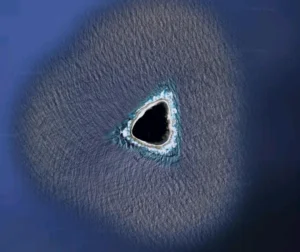Two weeks ago, Ukrainians Viacheslav Polezhaiko, Nikita Balabanov, and Mikhail Fomin solved one of the classic problems in Nepal’s Himalaya: the Southeast Ridge of Annapurna III (7,555m).
Expeditions had attempted the nearly 3,000m-long ridge for the last 40 years without success. The Ukrainians themselves tried in 2019 but had to turn back at 6,300m because of deep, unstable snow. This time, they had better luck. Still, the going was much tougher than they had expected. Each of them lost 12 to 15kg.

Annapurna III SE Ridge. Photo: Ukrainian Annapurna III team
The team assumed huge risks. The single push up the mountain lasted 18 days. They had food and fuel for 12 days. Despite optimistic forecasts, high winds pummeled them virtually every day. Once on top, the team started down a different side of the mountain, with no information or maps of the terrain.
Ensued a three-day nightmare in high winds. In the end, they successfully descended to the base of the ridge (5,000m). There, a helicopter took them to Kathmandu, exhausted and suffering from frostbitten fingers.
On the way home, all Mikhail Fomin could think of was hugging his family again. He spent only a few hours in Kyiv, just long enough to pick up his wife, son, and daughter and whisk them away for a holiday in sunny Turkey.
Still, he managed to find time to answer ExplorersWeb’s questions.

Fomin hugs his wife at the airport in Kyiv. Photo: Elisabeth Servatynska/Facebook
“Everybody in the mountaineering world knows about the challenge of Annapurna III,” Fomin said. “We all had to decide that we were ready for it. For some reason, this usually happens on my birthday, in the kitchen, after all the other guests have gone to sleep.”
Big plans and lessons learned
The process was no different this time, when the climbers met in December 2018. “We had several options to choose from, but for all three of us, Annapurna III looked the most attractive and logical next step in our climbing careers,” said Fomin. “We all wanted a big challenge and real adventure after several years of failure.”
He is referring to their unsuccessful attempt at a new route on Gasherbrum I in 2017 and their merely classic route success on Broad Peak in 2018.
That kitchen confab was the beginning of a long relationship with Annapurna III. The first try was in 2019. Although it didn’t go too well because of the rough conditions, they looked on it as the first round in a long-term quest.

Endurance, technical skills, and loads of patience carried the Ukrainians up Annapurna III: Photo: Ukrainian Annapurna III team
“Annapurna III’s SE Ridge is such a tactically complicated route that any team should consider their first expedition there only a reconnaissance,” Fomin said.
He noted that a huge part of their success this year came because they showed up having learned their lessons. So what did they learn? Fomin listed three key things:
First, we learned how and where to acclimatize. This year, we acclimatized on the slopes of Annapurna IV. We also spent two nights at 6,900m, which allowed us to work effectively at high altitude on Annapurna III for the two weeks that the climb took.
Second, we discovered all the possible routes and conditions on the lower, snowy part of the route. We’re talking about 1,400 vertical metres — up to 6,000m. That whole section is a sort of “snow pillow”, which constitutes the tactical crux of the route.
Finally, we were able to evaluate our speed and how much food and fuel we needed. We also figured out how to optimize our climbing gear and its quantity and weight.
Sticking to the rules of alpine style
In Nepal this fall, the team acclimatized in two laps, one up to 5,750m on the ridge between Annapurna III and Annapurna IV, and a second push up to Annapurna IV, with two nights at 6,900m. Those journeys prepared them for the main climb, which they did in a single, alpine-style push.

Annapurna III’s SE Ridge. Photo: Ukrainian Annapurna III team
“We didn’t make any food or fuel deposits ahead of time on the route,” said Fomin. “And there was no preliminary reconnaissance, except for our 2019 attempt.” They wanted to climb in the “cleanest possible style and the fairest means, as Conrad Anker requested in his article about Annapurna III,” Fomin explained.
The Ukrainians feel that they are a well-balanced team. “We all have pretty comparable experience and skills, so we prefer to make decisions jointly,” said Fomin. “But the really good thing is that our characters complement each other when we need to make decisions.”
Ex-Soviet toughness and “snow feeling”

The team right after being airlifted back to civilization. Photo: Ukrainian Annapurna III team
“For example, Nikita [Balabanov] has a more weighted and conservative approach to decisions. I am more assertive and sometimes even pushy with my opinion. Slava [Polezhaiko] can see both points of view and helps facilitate discussions. And our mutual respect for each other allows us to make strong tactical decisions. I consider that to be one of the strongest aspects of our team.
“Our other core strength is pretty common in former USSR climbers — the ability to suffer silently for a long time. And on that route, this was crucial. We had to stay patient, to fight constantly with uncertainty, to eat little but climb fast, and so on.”

A vertical ice pitch on Annapurna III. Photo: Ukrainian Annapurna III team
The last strength that Fomin wanted to highlight is Slava Polezhaiko’s special “snow feeling”.
“I have not seen any other alpinist who has such a fine feeling for different snow conditions that he has,” said Fomin. “When he was leading on Annapurna III, he always had an ice ax in one hand and a snow shovel in the other. This was his main tool to progress on all kinds of funky snow terrain — knife-sharp snow ridges, mushrooms, cornices, and other shitty and scary stuff. On that route, what really defines your speed is how quickly and effectively you deal with snow terrain.”
The climb
Mikhail Fomin described the climb stage by stage.
The lower snow/ice section – 4,600m to 6,100m
A bit of easy snow climbing at the beginning, followed by a series of snowy chutes and short sections of hard mixed climbing, led to a snow ridge. Here, we had sections of loose rocks covered with snow — hard to place protection, very loose and dangerous climbing. We spent four days here and mostly climbed at night, for better snow.

On the lower, snowy slopes of Annapurna III. Photo: Ukrainian Annapurna III team
This section was in much worse condition than during our 2019 attempt: less snow, much more exposed and steep sections of hard mixed climbing, and the same snow mushrooms in the middle part of the snow ridge.
As I mentioned, this was the tactical crux of the route, because you need more or less good snow conditions. The key is to spend as little effort and time here as possible.
The rock buttress – 6,100m to 7,100m
Now we entered the technical crux of the route. At 6,250m, there is a legendary chimney that you can clearly see in David Lama’s video. It was one of the most rotten technical pitches I have ever climbed. Almost every rock you touched broke off, so you had to be very careful climbing and aiding it.

Fomin deals with the chimney on Annapurna III: Photo: Ukrainian Annapurna III team
In general, from 6,100m to 6,500m, the quality of the rock is really bad. Only a couple of pitches have solid rock. Everything else is very loose.
At 6,500m, there is a “knife”: a huge, snow-covered ledge, visible even from Pokhara.
This is the highest point previously reached by other climbing parties on that route. We spent a night on the snow mushroom on top of this knife. The next day, we approached the rock buttress above it and continued climbing this terra incognita. It took two days to climb the rock section (about 200m) and another two days to climb a 400m mixed section. Finally, we topped the buttress and reached the ridge leading to the summit.

The bivy on “the Knife”. Photo: Ukrainian Annapurna III team
Until this point, we managed to find decent bivy places where we could build ledges for our tent. All three of us could sleep lying down. But the last night before the ridge was really bad. We had to chop a ledge on a 50˚ ice slope and build it up using a snow hammock. In the end, we had room only to sit, so the next day, we all felt a bit sleepy. It took us nine days to cover this section.
Snow ridge to the summit – 6,100m to 7,555m
Here, there were no technical difficulties. It was just very cold and windy. The forecast reported winds of 100kph for those days, but we think it was less: about 70kph. Still, it was very hard to move in, so it took us 1.5 days to reach the summit from 7,100m.

Finally, the summit. L/R: Viacheslav Polezhaiko and Mikhail Fomin, holding his daughter’s toy unicorn between his teeth. Photo: Ukrainian Annapurna III team
Reflections
Now back at home in Ukraine, Fomin concludes that the climb took longer than expected mainly because of the complexity and diversity of the terrain.
“Such loose rock required very delicate climbing. Sometimes we were afraid to kill our partners belaying us with the stones that were falling down,” he said. “In snow terrain, you had to take your shovel to lead, because otherwise, it was so unconsolidated that you did not have solid footholds to progress. And in the mixed terrain, you’re dealing with lots of loose rocks covered by fresh snow, so you have to be creative in finding ways to move forward.

Loose rock section on Annapurna III: Photo: Ukrainian Annapurna III team
“It felt like each day the mountain was presenting us with new intricate puzzles that we had to solve carefully, one by one,” Fomin said. “Moreover, each fresh puzzle extended your journey by another day. You had to be patient and find the inner resources to move on. So our initial estimate of 12 days round trip turned out to be 18 days.
“We consider patience to be one of the main qualities of an alpinist, and definitely Annapurna III developed this quality to a high degree. So we decided to name the route ‘Patience’.”
It is surprising, given such a professional team, that none of the three Ukrainians are full-time professional athletes. Explains Fomin: “Nikita is a mountain guide and he is supported by Mountain Equipment, Slava does some guiding in the mountains but mainly trains children and adult climbers as head of the mountaineering federation in Cherkasy [central Ukraine], and I work full-time in IT as a business analyst. I’m supported by Fram Equipment [a Ukrainian outdoor company].”

Summit views. Photo: Ukrainian Annapurna III expedition
In fact, highly difficult climbs on 6,000’ers and 7,000’ers have usually not been as attractive to sponsors and wider audiences as the 8,000’ers, especially Everest and K2. Yet sectors of the public are increasingly critical of commercialized 8,000m climbing and applauding smaller teams doing slightly smaller, technical mountains in style. Says Fomin:
“As Denis Urubko said, climbing 6b at 8,000m is always harder than climbing 6b at sea level, and is always harder than climbing 6b at 7,000m. So climbing a new technical route on an 8,000’er is always much more challenging than a similar line on a 6,000m or 7,000m peak.
“I put commercial climbs on the other side of the universe. That is not alpinism at all. It is an expensive high-altitude attraction for people who love posting selfies on Instagram. But when somebody climbs a new route on an 8,000m peak alpine style, like Marek Holecek on Gasherbrum I in 2017, that is a real adventure and exploratory alpinism of the highest quality.”
What’s next?
The three climbers are already considering their next goal.
“We always have a list of targets which are potentially interesting for us, but since we usually do not have sponsors, we never announce our plans before the expedition,” says Fomin. “Instead we go, climb to the top, and only then make the announcement, just like we did on Annapurna III.”

For their next adventure, the Ukrainians have an 8,000m peak in mind. Photo: Ukrainian Annapurna III team
Yet Fomin did leave us with a clue about their next expedition. “There are two candidates, both 8,000m, but we are all leaning toward one of them.”
It’s Fomin’s birthday next month. Seems like a good time for another late-night kitchen party to decide.






